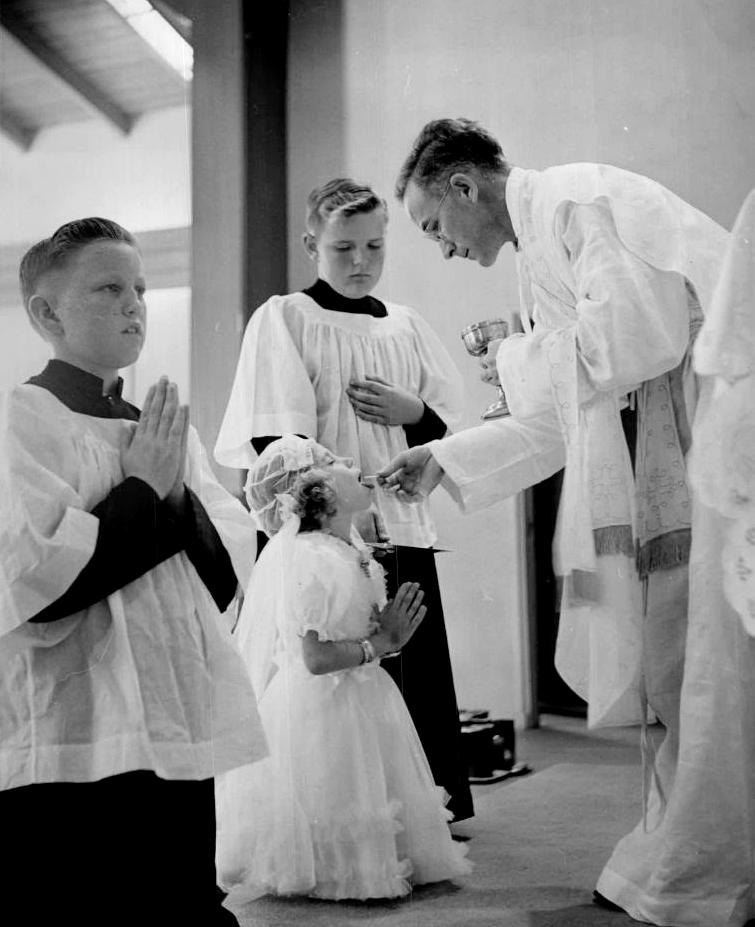
American Roman Catholics: Assimilation

Figure 1.--Here we a little American girl taking her First Communion, we think in the 1960s. By this time American Catholics had fully intehated into American mainline cultutre. Most Catholic churches no longer had a primarily ethnic parishioner composition, bith rather a mixed Irish, Italian, and other European ancestry.
|
|
The United States has a largely Protestant foundation. There was, however, no one single denomination. There were several Protestant disenrting churches in the northern colonies of varying importance. The Plymouth colony was founded by the Pilgrims, one of the dissenting groups. As more English colonists arrived, more denominations took root, inclusing the Anglican Church of England which became the established church as in England. The English/British appointed royal governors promoted the Anglican Church of England. In the southern colonies there were fewer disenting groups and the Anglican Church had even a greater importance. With the Revolution, the Constitution was basically silent on religion with the exception of Article 6 which states "[N]o religious Test shall ever be required as a Qualification to any Office or public Trust under the United States." It is the Bill of Rights (the First Amendment) that established the principle of Freedom of Religion which overode the religious provisions in state constitutions. This was very different than in England where Catholics faced a range of serious legaly based descrimination and even more in English-controlled Ireland. There were Catholic churches in Maryland, but the Catholic population in other states was relatively small. They faced varying degrees of discrimination, but not based in any legal bias. The first Catholics who came to America in large numbers were the Irish fleeing the famine (1840s). Anti-immigrant/anti-Catholic political groups like the Know Nothings began to form as well as natavist groups. Other Catholics began coming to America in large numbers from Italy and other countries with Catholic populations. Most of the Catholic immigrants settled in the growing indistrial cities. Parish churches were formed around ethnic groups. Thus the churches had a common theology, but national orientationn uch as Irish, Italian, Polish, and others. Catholic bishops as opposed to Parish priests began to see a need for comstructing an Ameican Catholic church free of ethnic identity. Until this happened, Protestant America would continue to see Catholics as immigrant outsiders and not fully trust Catholics. And Catholic bishops began to pursue this goal. Archbishop John Ireland of Minneapolis was the strongest advocate of Americanizing the Church. He and other bishops like Cardinal Cushing in Boston pursued the goal of stripping the ethenic identity of parish churches and persuading parishoners become fully American. The bishops realized that until this happened, Protestant America would look at Catholics as immigrant outsiders feeding into anti-Catholic feeling. As a result, the Catholic hierarchy began breaking the ties between the new arrivals and Europe. And the hierarchy embraced a range of American ideas such as freedom of speech and religion. At the same time other other development acted to unravel European ties, including 1) ecomomic opportunity created by American capitalism, 2) a fine public school system, 3) political power gained at the ballot box, 4) World War I, 6) World War II, and 7) finally the post-World War II move from the inner city to the suburbs where new parishes were founded without an ethnic foundation. As a result, Catholic Ameicans began sounding and looking like Protestant Americans, often with a more fervent patriotic edge than Protesants. A new development is mass legal and illegal immigration from Latin America, largely because of the failure of socialist policies in those countries.
HBC

Navigate the Boys' Historical Clothing Web Site:
[Return to theMain American Catholic page]
[Return to the Main U.S. religion page]
[Return to the Main religion country page]
[Introduction]
[Activities]
[Biographies]
[Chronology]
[Clothing styles]
[Countries]
[Bibliographies]
[Contributions]
[FAQs]
[Glossary]
[Images]
[Links]
[Registration]
[Tools]
[Boys' Clothing Home]
Created: 8:31 AM 3/14/2019
Last updated: 8:31 AM 3/14/2019



